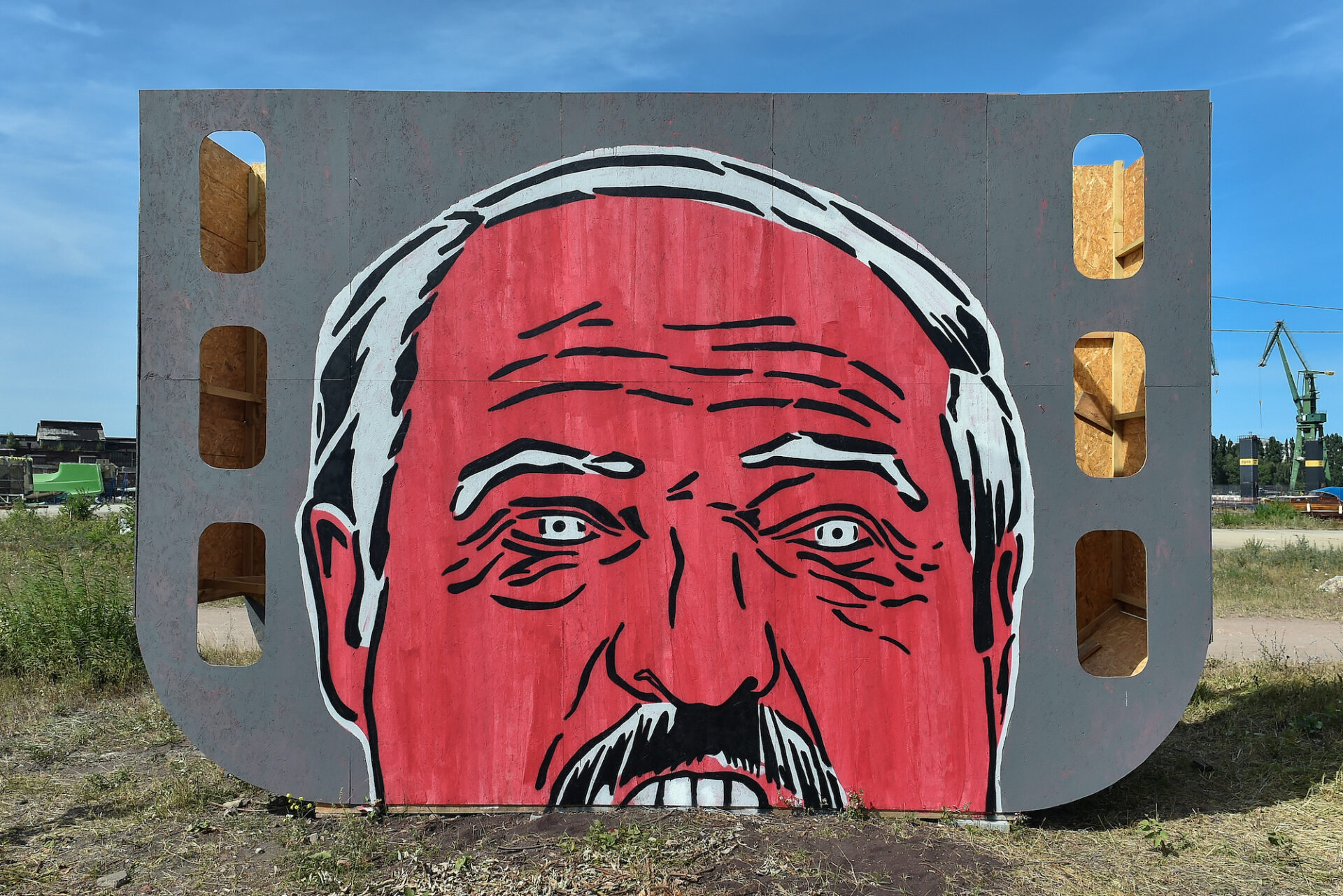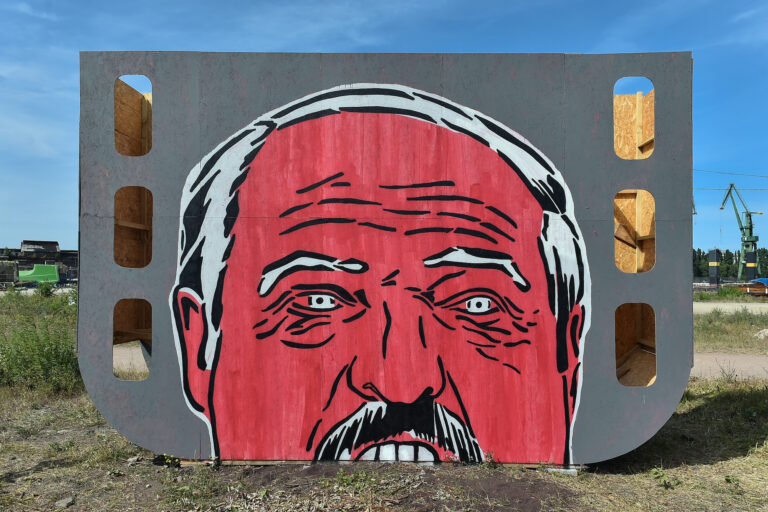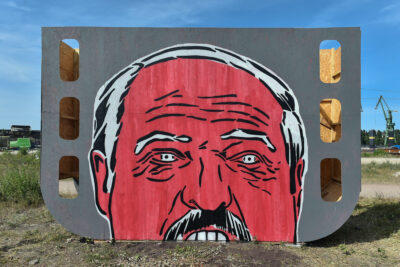Lukashenko is no longer in the business of engaging in politics or diplomacy. His actions are all about revenge, destruction and diversion, using violent tactics to target Belorussians themselves and his nation’s European neighbors.
by Michał Kacewicz
In early September 2021, Alaksandr Lukashenko showed off a new gift – one he received from a female student at the Academy of Arts who also happens to be the daughter of a KGB officer. It was a portrait showing Lukashenko and his teenage son Kolya both wearing bulletproof vests, holding Kalashnikov machine guns – the son wearing a special forces helmet. Behind them, the artist included a masked policeman or soldier wearing a black helmet and combat suit. The portrait presents a scene outside Minsk’s Independence Palace captured on 23 of August 2020 – a critical moment for Lukashenko’s regime. Protests and demonstrations were on the increase following the faking of the results of the presidential elections on 9 August – police violence flooding the streets of Belorussian cities and towns. The Independence Palace in the heart of Minsk, one of the President’s own headquarters, was surrounded by barbed wire and units of OMON operatives (specially trained military forces). By parading round with his son all armed and defiant, Lukashenko intended to show he was determined to fight in order to retain power and survive as ultimate ruler.
Nevertheless, the events of the latter half of August 2020 were one of the most traumatizing and extreme periods of Lukashenko’s rule. Just as they were for the Belorussian people. A year later, Lukashenko proudly showed off the painting representing his fight for survival – what he perceives to be his moment of victory – exhibiting extremes of pride and pomp characterized by cruelty little different to that of Idi Amin, the dictator of Uganda, known as the “Caesar of Bokassa”. This display of grotesque arrogance finds Lukashenko entering a period of great danger – a danger affecting both Belorussians and their neighbors in Central Eastern Europe.
Lukashenko used police violence and mass repressions to suppress the active, street stage of anti-government protests – thousands of Belorussians suffered (or are still suffering) torture behind the walls of police stations, prisons and detention centers. Human rights organizations estimate 657 prisoners in Belarus are at present “politicals”. Opposition leaders have been isolated – the likes of Maria Kalesnikava, Sergei Tikhanovsky and Viktar Babaryka have been imprisoned. On 6 September, Kalesnikava was handed an 11 year sentence in a penal colony, while Maksym Znak, another well known opposition activist, was sentenced to a decade behind bars. Others, such as Sviatlana Tsikhanouskaya and Pavel Latushko have been forced to flee Belarus, going into what amounts to exile.
As a result, Belorussian protests have changed tactics – mass public demonstrations have come to an end, with the exception of the odd small, desperate street protests. The great demonstrations announced for the spring did not take place. In February of 2021, certain the worst was behind him, Lukashenko proclaimed it a time of “normalization” and “national unity”. He even promised a vague sort of transformation to his rule and mystifying sort of reform plans. Lukashenko seems sure that with the aid of extensive and loyal security forces he will be able to survive any further challenges to his power, securing himself in a position of total authority. Only one thing now stands in his way.
These waves of violent repression resulted in a reaction from the West – the EU began introducing sanctions, which at first were relatively limited. Unlike EU politicians who take great care in making decisions, leaving room to maneuver in, Lukashenko has decided to use force in his international relations in order to challenge the West’s strategy of resorting to sanctions. Much as he did when on 23 August 2020 he picked up a machine gun to challenge demonstrators, he decided to show Europe he would not go down without a fight. On 23 May 2021, Belorussian military aircraft forced a passenger RyanAir flight to land in Minsk – leading to the capture and detention of Roman Protasevich, a blogger who supported anti-government protests. This act of military aggression and piracy was previously unheard of in the annals of modern European international relations. Much of what has transpired since shows this was Lukashenko’s attempt to barter with the EU – at the time of the hijacking of the RyanAir flight, a summit was taking place in Brussels where EU diplomats were due to discuss their political attitudes towards Russia. Instead, they green-lighted the introduction of a fourth packet of sanctions aimed at Belarus – which this time were a great deal more severe and damaging to the Belorussian economy.
As recently as May 2021, Lukashenko formulated new threats, renewing them in July, even if in the stream of recent accusations these somewhat faded out of sight – he claimed to be able to flood Europe with migrants, drugs and criminals. Soon after, migrants from the Middle East did indeed begin to appear on the border between Belarus and Lithuania, illegally crossing the 670 km long line of forests and fields.
More than 800 persons have recently crossed the border, which is substantially more than at any time last year. This migration crisis, or as Agne Bilotaite, the Lithuanian minister of internal affairs, called it “hybrid war”, caused the Lithuanian government to declare a state of emergency on the 2 July. Border guards and the army have been put on standby, with help being asked of Frontex, the European Border and Coast Guard Agency. Barbed wire defenses have been erected in the borderline forests, more than a hundred migrants from Iraq, Afghanistan, Africa and other Middle Eastern states being detained daily. It turned out Belorussian special forces had been preparing this “migration attack” for some time – word on the streets of Iraqi towns soon after was that it was easy to get to Europe using this corridor – first by plane to Baghdad or Istanbul on to Minsk, and then to the border with Lithuania, Latvia or Poland. All for a few thousand euros, attracting shady middlemen – Belorussian tour operators organizing trips to Europe, helping secure Belorussian visas.
This escalation of the migration crisis is Lukashenko’s attempt at getting his own back – especially when it comes to two neighboring states: Poland and Lithuania, which not only welcomed in Belorussian opposition activists, but are firmly behind European sanctions aimed against the regime in Minsk.
The organization of the air corridor for migrants to reach Minsk, and then trails towards the borders, is also an attempt to force the EU to withdraw sanctions put in place against Belarus. Lukashenko’s seems to be negotiating with full approval, and likely operational support, from Russian special forces, seeing as Belarus doesn’t have its own diplomatic base in Baghdad and the influence wielded by Russia in the Middle East is immeasurably greater than that of Belarus. The escalation of this particular crisis fits right in with existing Russian political strategies, which have far more long reaching intentions than those recently implemented by Belarus. Lukashenko is merely interested in quick-fire bartering with the EU and satisfying his desire for revenge. Putin in turn aims to deepen the sense of division and fear in Europe itself.
These were Russia’s aims behind the migration crisis of 2015, when it used misinformation, propaganda and the work of so-called “troll farms” and bots on social media to support anti-migration movements and political factions (the German AfD, France’s National Front, etc.). Moscow tried to create strategies which lead to more migration crises – such as when it made it easier for groups of migrants to cross over the borders to Norway in 2015 and early 2016. This was when migrants used bicycles to cross the border (Russian law forbids border crossings on foot) and following the influx of more than 5000 migrants in this way Norway claimed it was being attacked by Russia which was facilitating migration corridors across its territories – seeing as Norway was supporting the EU in its conflict with Russia. This is how Russian special forces experimented with inflicting migration crises upon affluent central and western European states.
Now, Lukashenko is using the same strategies, but the Norwegian experience is a lesson for all of Europe to learn from – five years ago, Norway tightened its borders with Russia and began sending back migrants who had used illegal means to cross over. Russia changed tack and closed the corridor facilitating migrant movements across its borders with Norway. Today, the same strategy is being tried by Poland and Lithuania as they strengthen their borders with their eastern neighbors – it’s just that Lukashenko, unlike Putin, is not interested in points scored on the international political stage, but is instead happy to simply go about causing chaos and problems for his neighbors. This being the essential nature of his regime – surviving and thriving as a ruler who merely does his best to be a European pest.
Michal Kacewicz @MKacewicz is a journalist and commentator at biełsat.eu and Newsweek Polska who specializes in Eastern and Central Europe. He is an author of the books: “Putin i spółka. Historia manipulacji” and “Sotnie wolności. Ukraina od Majdanu do Donbasu”.
The views and opinions expressed on our blog are those of the authors, representing a wide range of viewpoints, and do not necessarily reflect the position of VSquare or our affiliated organisations.
Cover photo: Mural depicting Alaksandr Lukashenko in Gdansk, Poland, 19.08.2020. Source: Lukasz Dejnarowicz / FORUM







